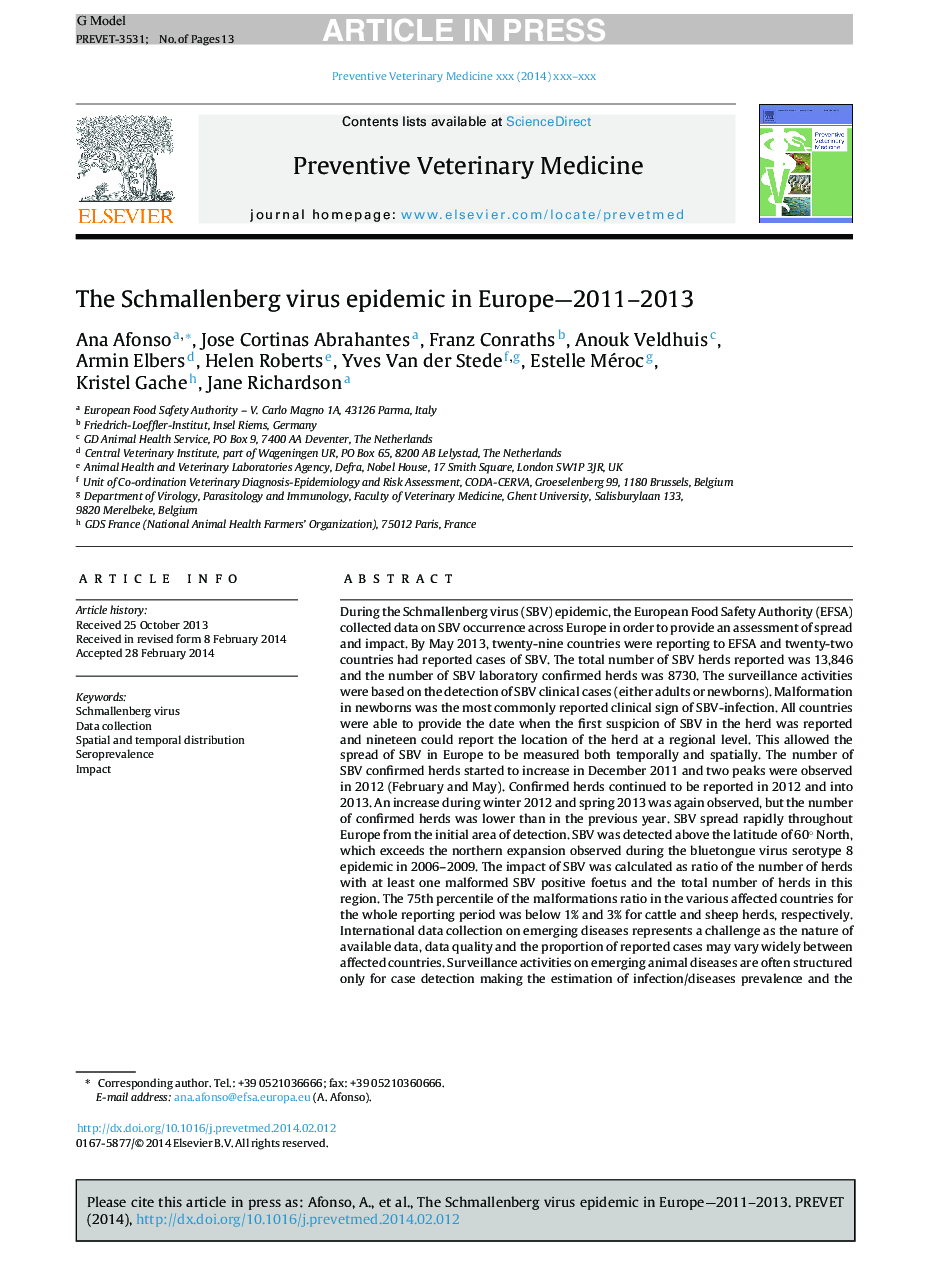| کد مقاله | کد نشریه | سال انتشار | مقاله انگلیسی | نسخه تمام متن |
|---|---|---|---|---|
| 5793398 | 1110014 | 2014 | 13 صفحه PDF | دانلود رایگان |
عنوان انگلیسی مقاله ISI
The Schmallenberg virus epidemic in Europe-2011-2013
دانلود مقاله + سفارش ترجمه
دانلود مقاله ISI انگلیسی
رایگان برای ایرانیان
کلمات کلیدی
موضوعات مرتبط
علوم زیستی و بیوفناوری
علوم کشاورزی و بیولوژیک
علوم دامی و جانورشناسی
پیش نمایش صفحه اول مقاله

چکیده انگلیسی
During the Schmallenberg virus (SBV) epidemic, the European Food Safety Authority (EFSA) collected data on SBV occurrence across Europe in order to provide an assessment of spread and impact. By May 2013, twenty-nine countries were reporting to EFSA and twenty-two countries had reported cases of SBV. The total number of SBV herds reported was 13,846 and the number of SBV laboratory confirmed herds was 8730. The surveillance activities were based on the detection of SBV clinical cases (either adults or newborns). Malformation in newborns was the most commonly reported clinical sign of SBV-infection. All countries were able to provide the date when the first suspicion of SBV in the herd was reported and nineteen could report the location of the herd at a regional level. This allowed the spread of SBV in Europe to be measured both temporally and spatially. The number of SBV confirmed herds started to increase in December 2011 and two peaks were observed in 2012 (February and May). Confirmed herds continued to be reported in 2012 and into 2013. An increase during winter 2012 and spring 2013 was again observed, but the number of confirmed herds was lower than in the previous year. SBV spread rapidly throughout Europe from the initial area of detection. SBV was detected above the latitude of 60° North, which exceeds the northern expansion observed during the bluetongue virus serotype 8 epidemic in 2006-2009. The impact of SBV was calculated as ratio of the number of herds with at least one malformed SBV positive foetus and the total number of herds in this region. The 75th percentile of the malformations ratio in the various affected countries for the whole reporting period was below 1% and 3% for cattle and sheep herds, respectively. International data collection on emerging diseases represents a challenge as the nature of available data, data quality and the proportion of reported cases may vary widely between affected countries. Surveillance activities on emerging animal diseases are often structured only for case detection making the estimation of infection/diseases prevalence and the investigation of risk factors difficult. The impact of the disease must be determined to allow risk managers to take appropriate decisions. Simple within-herd impact indicators suitable for emerging disease outbreaks should be defined that could be measured as part of routine animal health surveillance programmes and allow for rapid and reliable impact assessment of emerging animal health diseases.
ناشر
Database: Elsevier - ScienceDirect (ساینس دایرکت)
Journal: Preventive Veterinary Medicine - Volume 116, Issue 4, 15 October 2014, Pages 391-403
Journal: Preventive Veterinary Medicine - Volume 116, Issue 4, 15 October 2014, Pages 391-403
نویسندگان
Ana Afonso, Jose Cortinas Abrahantes, Franz Conraths, Anouk Veldhuis, Armin Elbers, Helen Roberts, Yves Van der Stede, Estelle Méroc, Kristel Gache, Jane Richardson,